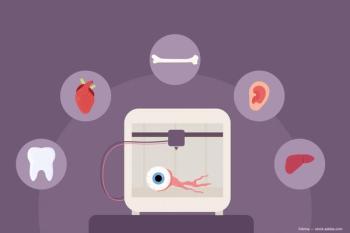
Anterior segment ischemia following three-muscle strabismus surgery
Case of anterior segment ischemia involves young adult with prior carotid artery injury.
Ophthalmology Times® is pleased to announce that Olivia J. Killeen, MD, a resident at Kellogg Eye Center, Department of Ophthalmology and Visual Sciences, University of Michigan with faculty mentors Adam Jacobson, MD, and Monte Del Monte, MD, is the third-place winner of the 2020 Resident Writers Award Program, sponsored by Allergan. Killeen’s entry is featured here.
Abstract
Anterior segment ischemia (ASI) is a rare but vision-threatening complication of strabismus surgery.
We present a case of ASI following three-muscle strabismus surgery in a young, healthy woman with a history of mild left carotid artery injury secondary to head trauma.
Three weeks after left medial rectus recession and total transposition of the left superior and inferior recti to the left lateral rectus to treat a traumatic left sixth nerve palsy, she had left pupil peaking and inferonasal iris atrophy.
She had no change in visual acuity and no anterior segment inflammation. Iris fluorescein angiography demonstrated delayed filling and neovascularization of the superotemporal iris.
She was diagnosed with ASI and treated with prednisolone acetate 1% four times dayily in the left eye. Her exam was stable over the next month.
To our knowledge, this is the first report of ASI after 3-muscle strabismus surgery in a young patient with prior mild unilateral carotid injury.
History
A 27-year-old woman presented to a pediatric ophthalmologist complaining of constant diplopia 8 months after suffering a traumatic brain injury (TBI) from being struck by a vehicle while riding a bicycle.
Relevant injuries included a basilar skull fracture, subdural hematoma, and brainstem and subarachnoid hemorrhages.
An MRA of the head and neck following her accident showed luminal narrowing and irregularity of the left carotid artery at the proximal petrous and petrous-cavernous junction.
Examination
Her visual acuity was 20/100 in the right eye and 20/70 in the left. Her intraocular pressure was 10 in both eyes. She had no afferent pupillary defect. She had incomplete blink in the right eye. The inferior one-third of the right cornea had an irregular surface with neovascularization.
Her right optic disc had mild pallor. Her slit lamp exam and dilated fundus exam were otherwise normal. The sensorimotor exam showed limited abduction of both eyes and limited supraduction, adduction, and infraduction of the right eye. She had an 85 prism diopter esotropia in primary gaze and near and a 35 prism diopter left hypertropia.
She had increased adduction on attempted elevation and depression of the right eye. She received a diagnosis of esotropia and right hypotropia from traumatic bilateral sixth nerve palsy and right third nerve palsy with aberrant regeneration of the right superior rectus to the right medial rectus.
Surgery to center the left eye was planned, followed later by surgery to align her right eye.
Surgical course
Utilizing 3 fornix incisions to preserve the limbal conjunctival circulation, she underwent a 6.5 mm left medial rectus recession on the adjustable suture and total transposition of the left superior rectus and inferior rectus to the left lateral rectus, with a 3 mm resection of both vertical recti.
In the initial week postoperatively, she complained of refractory left retrobulbar pain. On her first follow-up visit 3 weeks after surgery, she had superotemporal left pupil peaking and inferonasal iris atrophy (Figure 1).
Her best-corrected visual acuity was stable and she had no anterior chamber cell or flare. As expected, she had residual esotropia and left hypertropia in primary gaze. Iris fluorescein angiography demonstrated delayed filling and neovascularization of the superotemporal iris (Figure 2).
She received a diagnosis of ASI and started on prednisolone acetate 1% four times a day in the left eye. Her exam remained stable over the next month.
Four months after initial left eye surgery, she underwent total transposition of right superior rectus to lateral rectus with a 3 mm resection to correct the left hypotropia and total transposition of the right inferior rectus to the lateral rectus.
Right medial rectus recession was avoided to decrease the risk of ASI. She had no evidence of ASI after this procedure.
Discussion and diagnosis
ASI is a rare but vision-threatening complication of strabismus surgery. ASI occurs in approximately 1 out of 13,000 strabismus operations.1 ASI commonly presents with pupillary changes and anterior chamber cell and flare and can rarely lead to phthisis bulbi.2
Patient-related risk factors for ASI include age, compromised anterior segment circulation, hematologic disorders, atherosclerosis, and thyroid eye disease.2
In this otherwise healthy young woman, carotid artery injury was the only patient risk factor.
She suffered a left carotid artery injury 14 months before her initial left eye strabismus surgery, but she showed no clinical signs of left carotid insufficiency.
Greater numbers of muscles operated on are a risk factor for ASI. The simultaneous recession of 2 to 3 recti muscles in primates occasionally produced transient ASI, whereas simultaneous recession of all 4 recti muscles produced serious, permanent ASI.3
In adult humans, there is an additive effect on anterior segment circulation disruption when more than 1 rectus muscle is disrupted.4 Fornix incisions may decrease but do not eliminate the risk of ASI.2,5
Vertical rectus muscle disruption impacts anterior segment circulation more than horizontal rectus surgery.
In one study, all 17 adults who underwent primary vertical rectus surgery had angiographic ASI on postoperative day 1, and 6 had signs of ASI on slit lamp exam.
In contrast, there were no angiographic or clinical signs of ischemia in the 15 patients who underwent secondary vertical rectus or primary or secondary horizontal rectus surgery.6
Results from another study of anterior segment indocyanine green angiography (ICGA) after strabismus surgery found filling delays in all primary vertical recti surgeries but no delays after primary horizontal recti surgery.7
We confirmed the diagnosis of ASI in this patient using iris fluorescein angiography. Iris vasculature can also be visualized using ICGA or optical coherence tomography angiography (OCT-A).7,8
Angiographic abnormalities often improve or resolve weeks to months after surgery, but they can persist years later.6,7
Topical steroids are a common treatment for ASI, but it is unknown whether treatment changes the natural history.2 Clinical signs typically resolve over time.
Occasionally, iris atrophy and pupil changes persist.9 Final visual acuity is typically unchanged from preoperative visual acuity.1
To our knowledge, this is the first report of ASI in a young, healthy patient with prior unilateral carotid injury undergoing three-muscle strabismus surgery.
However, ASI following strabismus surgery was reported in a young man with prior left internal carotid artery ligation.10
He underwent left medial rectus recession and left lateral rectus resection for a sixth nerve palsy followed by lateral transposition of the vertical recti 9 years later. He developed ASI after the transposition.
Another healthy young man with abducens palsy following TBI developed severe ASI after medial rectus recession combined with temporal transposition of both vertical recti.9 That patient had no history of carotid disruption, but given his lack of other risk factors, it is possible that his trauma caused undiagnosed carotid injury.
Our case demonstrates that ASI can occur in a healthy patient with mild carotid disease after three-muscle strabismus surgery.
This case highlights the importance of obtaining complete records following traumas to identify ASI risk factors preoperatively. It is possible that preoperative iris angiography or OCT-A could have prompted modifications to this surgical plan.11 The surgery could have been performed in a staged fashion, which may have decreased the risk of ASI.2
Alternatively, we could have preserved the anterior ciliary vessels or considered ciliary sparing augmented adjustable transposition surgery to reduce the likelihood of ischemia.2,12
Conclusion
ASI can occur in a healthy, young patient with mild carotid injury undergoing three-muscle strabismus surgery, even using fornix incisions. In patients with head trauma, anterior segment imaging may help guide surgical planning.
--
References
1. France TD, Simon JW. Anterior segment ischemia syndrome following muscle surgery: the AAPO&S experience. J Pediatr Ophthalmol Strabismus. 1986;23(2):87-91.
2. Saunders RA, Bluestein EC, Wilson ME, Berland JE. Anterior segment ischemia after strabismus surgery. Surv Ophthalmol. 1994;38(5):456-466. doi:10.1016/0037-6257(94)90175-9
3. Virdi PS, Hayreh SS. Anterior segment ischemia after recession of various recti. An experimental study. Ophthalmology. 1987;94(10):1258-1271. doi:10.1016/s0161-6420(87)80009-x
4. Olver JM, Lee JP. Recovery of anterior segment circulation after strabismus surgery in adult patients. Ophthalmology. 1992;99(3):305-315. doi:10.1016/s0161-6420(92)31971-2
5. Fishman PH, Repka MX, Green WR, D'Anna SA, Guyton DL. A primate model of anterior segment ischemia after strabismus surgery: the role of the conjunctival circulation. Ophthalmology. 1990;97(4):456-461. doi:10.1016/s0161-6420(90)32561-7
6. Olver JM, Lee JP. The effects of strabismus surgery on anterior segment circulation. Eye (Lond). 1989;3(Pt 3):318-326. doi:10.1038/eye.1987.46
7. Chan TK, Rosenbaum AL, Rao R, Schwartz SD, Santiago P, Thayer D. Indocyanine green angiography of the anterior segment in patients undergoing strabismus surgery. Br J Ophthalmol. 2001;85(2):214-218. doi:10.1136/bjo.85.2.214
8. Velez FG, Davila JP, Diaz A, Corradetti G, Sarraf D, Pineles SL. Association of change in iris vessel density in optical coherence tomography angiography with anterior segment ischemia after strabismus surgery. JAMA Ophthalmol. 2018;136(9):1041-1045. doi:10.1001/jamaophthalmol.2018.2766
9. Fells P. Anterior segment ischaemia. Lens changes after strabismus surgery. Trans Ophthalmol Soc U K. 1980;100(3):398-399.
10. Saunders RA, Sandall GS. Anterior segment ischemia syndrome following rectus muscle transposition. Am J Ophthalmol. 1982;93(1):34-38. doi:10.1016/0002-9394(8)90695-x
11. Kaeser PF, Klainguti G. Anterior segment angiography in strabismus surgery. Klin Monbl Augenheilkd. 2012;229(4):362-364. doi:10.1055/s-0031-1299283
12. Pineles SL, Chang MY, Oltra EL, Pihlblad MS, Davila-Gonzalez JP, Sauer TC, et al. Anterior segment ischemia: etiology, assessment, and management. Eye (Lond). 2018;32(2):173-178. doi:10.1038/eye.2017.248
Newsletter
Don’t miss out—get Ophthalmology Times updates on the latest clinical advancements and expert interviews, straight to your inbox.









































